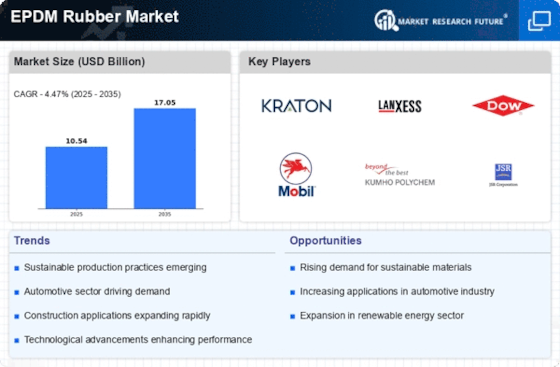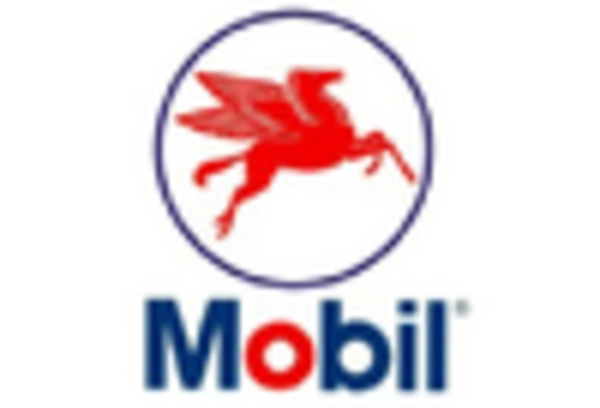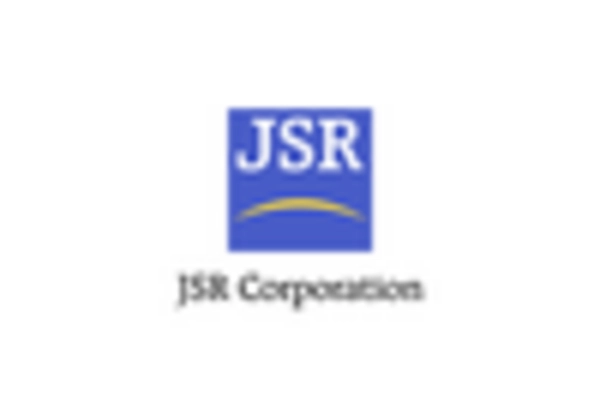Growth in Construction Activities
The construction industry is witnessing a resurgence, leading to increased demand for EPDM rubber in various applications such as roofing, waterproofing, and insulation. EPDM rubber's superior resistance to UV radiation and ozone makes it an ideal choice for roofing membranes, which are essential for energy-efficient buildings. In 2025, the construction sector is expected to contribute significantly to the EPDM Rubber Market, as more projects emphasize sustainability and energy efficiency. The global push for green building practices further enhances the appeal of EPDM rubber, as it aligns with the industry's goals of reducing environmental impact. Consequently, the EPDM Rubber Market is poised for growth, driven by the expanding construction activities and the material's favorable properties.
Rising Demand in Automotive Sector
The automotive sector is experiencing a notable increase in demand for EPDM rubber, primarily due to its excellent weather resistance and durability. EPDM rubber is extensively utilized in automotive seals, gaskets, and hoses, which are critical for vehicle performance and longevity. As the automotive industry continues to evolve, with a focus on electric vehicles and enhanced fuel efficiency, the EPDM Rubber Market is likely to benefit significantly. In 2025, the automotive sector is projected to account for a substantial share of the EPDM rubber consumption, driven by the need for lightweight materials that do not compromise on performance. This trend suggests a robust growth trajectory for the EPDM Rubber Market, as manufacturers seek materials that meet stringent quality and performance standards.
Increasing Environmental Regulations
The EPDM Rubber Market is increasingly influenced by stringent environmental regulations aimed at reducing the carbon footprint of manufacturing processes. Governments are implementing policies that encourage the use of sustainable materials, which is likely to drive the adoption of EPDM rubber due to its recyclable nature and low environmental impact. In 2025, compliance with these regulations is expected to become a key driver for manufacturers, prompting them to invest in eco-friendly production methods. This shift not only aligns with global sustainability goals but also enhances the marketability of EPDM rubber products. As a result, the EPDM Rubber Market may experience a surge in demand from sectors that prioritize environmentally responsible materials.
Expanding Applications in Consumer Goods
The versatility of EPDM rubber is leading to its expanding applications in the consumer goods sector, including products such as footwear, toys, and household items. Its excellent resistance to wear and tear, along with its ability to withstand various environmental conditions, makes it a preferred choice for manufacturers. In 2025, the consumer goods segment is anticipated to contribute significantly to the EPDM Rubber Market, as brands increasingly seek durable and high-performance materials. This trend suggests a growing recognition of the benefits of EPDM rubber, potentially leading to innovative product designs and enhanced consumer satisfaction. As the market evolves, the EPDM Rubber Market is likely to capitalize on these emerging opportunities.
Technological Innovations in Manufacturing
Technological advancements in the manufacturing processes of EPDM rubber are playing a crucial role in enhancing product quality and performance. Innovations such as improved compounding techniques and advanced curing methods are enabling manufacturers to produce EPDM rubber with superior properties, including enhanced elasticity and resistance to extreme temperatures. These advancements are likely to attract new applications within the EPDM Rubber Market, expanding its reach beyond traditional uses. As manufacturers adopt these technologies, the overall efficiency and cost-effectiveness of production are expected to improve, potentially leading to lower prices for consumers. This dynamic could stimulate demand across various sectors, further solidifying the position of the EPDM Rubber Market in the materials landscape.


















Leave a Comment